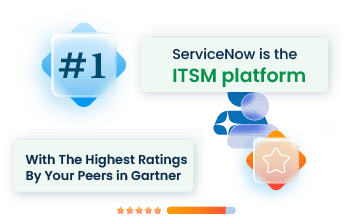“ServiceNow Integration holds a crucial role in modern IT and business environments. Integrating ServiceNow with other systems creates a seamless flow of information, boosting operational agility and improving decision-making. Whether connecting with Jira for project management or integrating with Azure for cloud services, the potential is vast.
This article outlines the key benefits, types, and best practices for ServiceNow Integration. By the end, you’ll understand why ServiceNow Integration matters and how it can address your specific needs. Dive in to see how these integrations can transform your workflows and make your processes smoother and more efficient.
What is ServiceNow Integration?
ServiceNow integration connects the ServiceNow platform with various external applications, tools, and systems (Jira, Azure, Splunk, McAfee, LDAP, and Salesforce). This connection allows seamless data sharing, task automation, and enhanced workflow capabilities.
By integrating ServiceNow, businesses achieve a unified view of their operations, streamlining processes across IT, HR, customer service, and other departments. Integration types vary, including API-based connections, middleware, and third-party tools, each catering to different business needs and technical environments.
Incorporating ServiceNow into your existing infrastructure helps to reduce manual errors and provide better visibility into processes, ultimately driving business success. When systems work together, your teams can focus on strategic tasks rather than manual data entry.
Key Benefits of ServiceNow Integration
ServiceNow integration provides a unified platform, streamlining various business operations and addressing key challenges faced by enterprises. Here are the primary benefits:
1. Improved Data Accuracy and Accessibility ServiceNow integration brings together data from multiple sources into a single platform. This consolidation reduces errors, ensuring accurate information. Accessing data from one place allows for better decision-making and operational clarity.
2. Enhanced Collaboration Across Teams Integrating ServiceNow with other systems fosters better communication and collaboration. Teams, such as IT and business units, can work together more smoothly. This coordination helps in resolving issues faster and enhances overall productivity.
3. Automated Workflows and Processes ServiceNow integration automates repetitive tasks and workflows, freeing up valuable time for employees to focus on strategic activities. Automation reduces manual intervention, minimizes errors, and speeds up processes, resulting in increased operational efficiency.
4. Real-Time Monitoring and Reporting With integration, ServiceNow offers real-time monitoring and reporting capabilities. Organizations can track performance metrics, identify bottlenecks, and address issues promptly. This feature ensures continuous improvement and helps maintain service quality.
5. Scalability and Flexibility ServiceNow integrations provide a scalable solution, accommodating growing business needs. Whether adding new applications or expanding existing ones, the platform adapts without significant disruptions. This flexibility supports long-term growth and change.
Types of ServiceNow Integrations
Understanding the various types of ServiceNow integrations can greatly impact your business workflow. Let’s dive into the key integration types and their business implications.
Event Management Integration
This integration helps in correlating events from multiple sources, creating a unified view of your IT infrastructure. It allows real-time monitoring and proactive incident management, reducing downtime and improving service quality. Your IT team can quickly identify and address issues, maintaining seamless business operations.
Import Set API Integration
With this integration, data from various external sources can be imported into ServiceNow. It automates data collection, ensuring data consistency and accuracy. This simplifies data management, reducing manual efforts and errors, and providing reliable data for decision-making.
Lookup Source Integration
This type allows querying external data sources directly from ServiceNow. It provides real-time access to critical information without data duplication. Your teams can make informed decisions quickly, enhancing responsiveness and service delivery.
Threat Source Integration
Integrating threat intelligence feeds with ServiceNow enhances your security posture. It enables real-time threat detection and response, protecting your business from potential cyber threats. Security teams can act swiftly on credible threats, minimizing risks and ensuring business continuity.
Data Integration
This integration facilitates seamless data exchange between ServiceNow and other systems. It ensures data consistency across platforms, supporting accurate reporting and analytics. It streamlines operations, providing a single source of truth for your data needs, aiding in strategic planning and performance tracking.
Scanner Invocation Integration
This integration involves invoking external scanners from within ServiceNow. It automates scanning processes, improving efficiency and reducing manual intervention. IT teams can maintain compliance and security standards effortlessly, ensuring up-to-date vulnerability management.
ServiceNow Integration with Popular Applications
Integration with Jira
ServiceNow and Jira work together to streamline project management and IT service management. By connecting these platforms, you achieve seamless ticket flow between your development and IT teams. This integration helps in tracking issues, coordinating tasks, and managing project timelines without duplication of efforts. The synchronization of tickets, status updates, and comments ensures transparency and reduces manual work, ultimately boosting productivity.
Integration with Azure
ServiceNow’s integration with Azure allows for automated management of cloud resources. Azure’s robust cloud services, when combined with ServiceNow, enable you to handle virtual machines, storage, and databases with precision. This integration supports incident management, change management, and real-time monitoring of cloud infrastructure. By automating workflows, you minimize the risk of human error and ensure consistent cloud operations, enhancing your overall IT service delivery.
Integration with Splunk
ServiceNow and Splunk integration offers a powerful combination for IT operations and security. Splunk’s data analysis capabilities paired with ServiceNow’s workflow automation lead to proactive issue resolution. This setup facilitates <strong>real-time alerts, incident tracking, and root cause analysis.</strong> Your team gains a unified view of system performance and security events, which improves incident response times and ensures compliance with security policies.
Integration with McAfee
By integrating ServiceNow with McAfee, you enhance your security management processes. This integration automates threat detection and response, linking security events from McAfee with ServiceNow’s incident management.
This can provide a streamlined approach to security operations, allowing for faster threat resolution and reducing the workload on your security team. You maintain a secure environment without sacrificing operational efficiency.
Integration with LDAP
ServiceNow’s integration with LDAP (Lightweight Directory Access Protocol) simplifies user authentication and access control. This integration allows for centralized management of user credentials and permissions. By synchronizing LDAP with ServiceNow, you streamline user provisioning and de-provisioning, ensuring that access rights are always up-to-date. This reduces administrative overhead and enhances security across your organization.
Integration with Salesforce
Connecting ServiceNow with Salesforce creates a unified platform for customer service and IT support. This integration allows your teams to handle customer queries and technical issues in a cohesive manner. By synchronizing data between ServiceNow and Salesforce, customer service representatives have all necessary information at their fingertips, improving response times and customer satisfaction. This leads to a more efficient workflow and better customer experiences.
Integration with Human Resource Management Systems
ServiceNow integrates smoothly with various Human Resource Management Systems (HRMS). This integration automates HR workflows such as onboarding, offboarding, and employee data management. By connecting ServiceNow with HRMS, HR processes become more efficient, reducing manual data entry and improving employee satisfaction. This ensures that HR operations run smoothly, allowing your HR team to focus on strategic tasks.
Integration of Communication Tools
Integrating ServiceNow with communication tools like Slack, Microsoft Teams, or Zoom enhances collaboration across your organization. This integration facilitates real-time communication within incident management, change requests, and project updates. By embedding communication tools within ServiceNow workflows, you enable your teams to stay connected and informed, improving decision-making and operational efficiency.
Native and Third-Party Integration Solutions
Native Ways to Implement ServiceNow Integrations
ServiceNow offers built-in tools that connect your existing applications. These native solutions include options like IntegrationHub, which allows for workflow automation and data exchange without leaving the ServiceNow environment. This approach provides a seamless experience, reducing the risk of data loss or miscommunication.
Using Third-Party Apps for ServiceNow Integrations
Third-party apps provide flexibility, especially when dealing with multiple external systems. These apps often come with pre-built connectors and templates, making integration tasks more manageable. Tools like Mulesoft or Boomi allow for a broad range of connectivity, supporting various protocols and platforms.
Third-party apps can streamline complex integrations, saving time and resources. This flexibility allows your business to adapt quickly to new requirements, ensuring that all systems communicate effectively.
Exalate: A Third-Party Integration Solution for ServiceNow Integrations
Exalate offers a robust solution for integrating ServiceNow with other systems. It supports both cloud and on-premises environments, providing real-time synchronization. With Exalate, users can configure custom scripts to handle unique integration needs, making it a versatile tool for businesses with specific requirements.
Exalate’s real-time synchronization ensures that data remains consistent across all platforms. This reliability helps in maintaining accurate records and enhances decision-making processes. The custom scripting capability allows for tailored integrations, aligning perfectly with your business strategies.
Implementing ServiceNow Integrations
Step 1: Install Integration Tools
Begin by selecting and installing the appropriate tools for your integration needs. ServiceNow offers native tools and third-party solutions like Exalate. Installation involves setting up these tools within your ServiceNow environment and ensuring they align with the systems you aim to connect.
Correct tool installation ensures compatibility and sets the foundation for a smooth integration process, reducing initial setup issues.
Step 2: Connect ServiceNow and Other Applications
Establish a connection between ServiceNow and the other applications. This involves configuring API endpoints and authentication protocols to allow data flow. Ensure all security measures are in place to protect sensitive information.
Establishing a secure connection enables safe and reliable data exchange, critical for maintaining data integrity and compliance.
Step 3: Configure Connections
Define what data will be shared between ServiceNow and the connected applications. This includes setting up data mappings, workflows, and conditions under which data transfer occurs. Fine-tuning these settings tailors the integration to meet your business requirements.
Proper configuration ensures relevant data is shared and workflows operate smoothly, aligning with your business processes and improving operational efficiency.
Step 4: Start Automatic Synchronization
Initiate automatic synchronization to enable real-time data exchange. Configure triggers that determine when data synchronization occurs, ensuring the information remains up-to-date across all systems.
Automatic synchronization keeps all connected systems in sync, reducing manual data entry and minimizing errors, thus saving time and effort.
Step 5: Monitor and Maintain Integrations
Regular monitoring and maintenance are crucial. This involves tracking integration performance, troubleshooting issues, and updating configurations as needed to adapt to changing business needs.
How to Overcome Integration Challenges
Addressing Common Issues with ServiceNow Integrations
Integrating ServiceNow with other systems often brings hurdles like data inconsistency, latency, and API limits. These challenges disrupt workflow and lead to inefficiencies. Addressing these issues involves thorough planning and robust architecture. By mapping data flows and setting up precise integration points, these problems get minimized. This approach ensures seamless operations, which means less downtime and higher productivity for your business.
Data Security and Compliance
Maintaining data security during integration holds paramount importance. Secure data transfer protocols and strict access controls protect sensitive information. Compliance with industry regulations, such as GDPR or HIPAA, safeguards your business from legal issues. This layer of security means your business maintains trust with clients and partners, fostering long-term relationships and reducing the risk of costly breaches.
Managing Decentralized and Loosely-Coupled Systems
ServiceNow integrations often involve decentralized systems with varying degrees of coupling. Managing these systems calls for a flexible and modular approach. Using microservices architecture and API gateways allows independent system updates without affecting the whole ecosystem. This method supports scalability and adaptability, which means your business can quickly respond to changes and grow without major overhauls.
Best Practices for ServiceNow Integrations
Implementing ServiceNow integrations efficiently involves several key practices. Proper planning and requirement capture set the foundation for success. Clear objectives and detailed requirements ensure all stakeholders align, minimizing risks. Capturing requirements involves detailed documentation and engaging with all relevant departments to gather insights. This step impacts your business by reducing rework and improving the integration’s relevance to your needs.
Considering the impact on end-users cannot be overlooked. User experience dictates adoption rates and satisfaction levels. Integration should streamline workflows, not complicate them. Understanding user needs and testing workflows in a controlled environment before full deployment can help identify potential issues. Addressing these concerns improves productivity and user satisfaction, leading to smoother operations.
Mapping and testing integration workflows ensures the integration functions as intended. Detailed mapping of workflows identifies dependencies and potential conflict areas. Rigorous testing in a sandbox environment helps catch issues early, preventing disruptions in live environments. This practice impacts your business by ensuring reliability and performance, which are crucial for maintaining operational continuity.
Implementing ServiceNow Integrations Faster requires an agile approach. Breaking the project into smaller phases allows for quick wins and adjustments along the way. Regular reviews and iterative improvements help in adapting to changing requirements and minimizing downtime. This approach speeds up the overall process and delivers value incrementally, supporting faster return on investment.
Advanced Integration Strategies
Achieving Fast Time-to-Value Integrations with Integration Service Providers
Service providers streamline ServiceNow integrations by managing the entire process from planning to execution. This approach minimizes downtime and accelerates the time to realize benefits. By using expert teams and proven methodologies, integration service providers ensure smooth transitions, reducing the risk of errors and delays. This method impacts your workflow by freeing up internal resources, allowing your team to focus on core business activities.
Leveraging Big Data Integration
Integrating ServiceNow with big data platforms transforms raw data into actionable insights. This integration enables better decision-making through real-time analytics and reporting. For businesses, this means having access to comprehensive data sets that drive informed strategies and optimize performance. Incorporating big data enhances predictive maintenance, customer service, and overall operational efficiency.
Enabling Growth and Change Through Connectivity
Connecting various systems with ServiceNow fosters a cohesive IT ecosystem, supporting business agility. Seamless connectivity ensures that all departments can communicate and collaborate effectively, leading to improved innovation and adaptability. This connectivity allows your business to scale and adapt to market changes swiftly, maintaining a competitive edge.
Key Considerations for ServiceNow Integration
Compatibility and Interoperability
Compatibility and interoperability hold critical importance for integrating ServiceNow with existing systems. Ensuring that ServiceNow can seamlessly interact with other applications guarantees a smooth workflow. This helps avoid disruptions and promotes a unified system environment.
Scalability and Performance
Scalability addresses the need for your system to grow without losing performance. As your organization expands, ServiceNow integrations should handle increased workloads efficiently. High performance ensures that the system remains responsive, providing a reliable user experience.
Monitoring and Maintenance
Monitoring and maintenance ensure the health and functionality of your integrations. Regular checks and updates help identify issues early and keep the system running smoothly. Effective monitoring provides insights into system performance, aiding in proactive management.
Vendor Support and Resources
Vendor support and resources offer crucial assistance during integration and beyond. Access to a knowledgeable support team and comprehensive resources ensures quick resolution of issues and provides guidance on best practices. This support helps maintain a stable and efficient integration environment.
Conclusion
ServiceNow integration brings profound changes to your business operations. Seamless integration between systems improves data flow and operational efficiency. Real-time data synchronization ensures that your teams stay aligned, reducing errors and increasing productivity.
Take the next step—connect with our team for a consultation to uncover how ServiceNow integration can streamline your processes and drive your business forward. Our experts are ready to assist you in achieving seamless integrations tailored to your needs.












